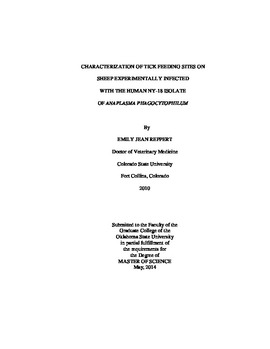| dc.contributor.advisor | Kocan, Katherine M. | |
| dc.contributor.author | Reppert, Emily Jean | |
| dc.date.accessioned | 2015-06-17T20:07:40Z | |
| dc.date.available | 2015-06-17T20:07:40Z | |
| dc.date.issued | 2014-05-01 | |
| dc.identifier.uri | https://hdl.handle.net/11244/15085 | |
| dc.description.abstract | Anaplasma phagocytophilum, first identified as a pathogen of ruminants in Europe, has more recently been recognized as an emerging tick-borne pathogen of humans in the U.S. and Europe. A. phagocytophilum is transmitted primarily by ticks of the genus Ixodes. Our laboratory recently developed a sheep model for study of the host/ tick/pathogen interactions of the human NY-18 isolate of A. phagocytophilum. In this model, sheep became infected with the pathogen within 14 days after inoculation but did not exhibit clinical signs and infected morulae were rarely seen in stained blood smears. However, when ticks were allowed to feed on the infected sheep, they readily acquired A. phagocytophilum infection, and 80% to 100% of the tick salivary glands and guts were confirmed by PCR to be infected after a 2- to 4-day feeding period. In this research we examined tick feeding sites to determine the source of A. phagocytophilum infection for the ticks using PCR and immunohistochemistry (IHC). Postmortem skin biospies were taken directly below tick feeding sites, fixed in buffered formalin and embedded in paraffin. IHC was done using antibodies against recombinant major surface protein 4 (MSP4) that were indirectly labeled with fluorescein (FA) or peroxidase-antiperoxidase (PAP) and then examined with confocal or light microscopy. Expression of immune response genes, shown previously to be differentially regulated in response to A. phagocytophilum infection in sheep, was determined by qRT-PCR in blood and skin biopsies. Variable expression of these genes was observed in tick and non-tick feeding sites of infected and uninfected sheep. Granuloctyes infected with A. phagocytophilum were detected in skin biopsies by both IHC methods. Tick feeding appears to attract infected neutrophils and therefore contributes to the exposure and infection of ticks with A. phagocytophilum after short feeding periods. | |
| dc.format | application/pdf | |
| dc.language | en_US | |
| dc.publisher | Oklahoma State University | |
| dc.rights | Copyright is held by the author who has granted the Oklahoma State University Library the non-exclusive right to share this material in its institutional repository. Contact Digital Library Services at lib-dls@okstate.edu or 405-744-9161 for the permission policy on the use, reproduction or distribution of this material. | |
| dc.title | Characterization of Tick Feeding Sites on Sheep Experimentally Infected with the Human Ny-18 Isolate of Anaplasma Phagocytophilum | |
| dc.type | text | |
| dc.contributor.committeeMember | Streeter, Robert N. | |
| dc.contributor.committeeMember | Fuente, Jose de la | |
| dc.contributor.committeeMember | Blouin, Edmour | |
| osu.filename | Reppert_okstate_0664M_13273.pdf | |
| osu.accesstype | Open Access | |
| dc.description.department | Veterinary Biomedical Sciences | |
| dc.type.genre | Thesis | |
| dc.subject.keywords | anaplasma phagocytophilum | |
| dc.subject.keywords | immunocytochemistry | |
| dc.subject.keywords | ixodes scapularis | |
| dc.subject.keywords | tick bite site | |
